
|
Astronomy Picture Of the Day (APOD)
 APOD: 2020 August 19 B The Sun Rotating
APOD: 2020 August 19 B The Sun Rotating
19.08.2020
Does the Sun change as it rotates? Yes, and the changes can vary from subtle to dramatic. In the featured time-lapse sequences, our Sun -- as imaged by NASA's Solar Dynamics Observatory -- is shown rotating though an entire month in 2014.
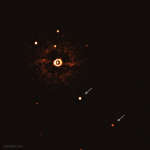 APOD: 2020 August 18 B TYC 8998 760 1: Multiple Planets around a Sun Like Star
APOD: 2020 August 18 B TYC 8998 760 1: Multiple Planets around a Sun Like Star
18.08.2020
Do other stars have planets like our Sun? Previous evidence shows that they do, coming mostly from slight shifts in the star's light created by the orbiting planets. Recently, however, and for the first time, a pair of planets has been directly imaged around a Sun-like star.
 Perseids Around the Milky Way
Perseids Around the Milky Way
17.08.2020
Why would meteor trails appear curved? The arcing effect arises only because the image artificially compresses (nearly) the whole sky into a rectangle. The meteors are from the Perseid Meteor Shower that peaked last week.
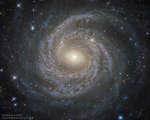 APOD: 2020 August 16 B NGC 6814: Grand Design Spiral Galaxy from Hubble
APOD: 2020 August 16 B NGC 6814: Grand Design Spiral Galaxy from Hubble
16.08.2020
In the center of this serene stellar swirl is likely a harrowing black-hole beast. The surrounding swirl sweeps around billions of stars which are highlighted by the brightest and bluest. The breadth and beauty of the display give the swirl the designation of a grand design spiral galaxy.
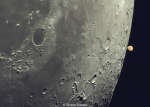 APOD: 2020 August 15 B Mars at the Moons Edge
APOD: 2020 August 15 B Mars at the Moons Edge
15.08.2020
Does the Moon ever block out Mars? Yes, the Moon occasionally moves in front of all of the Solar System's planets. Just this past Sunday, as visible from some locations in South America, a waning gibbous Moon eclipsed Mars.
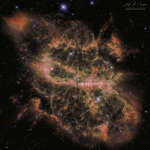 APOD: 2020 August 14 B NGC 5189: An Unusually Complex Planetary Nebula
APOD: 2020 August 14 B NGC 5189: An Unusually Complex Planetary Nebula
14.08.2020
Why is this nebula so complex? When a star like our Sun is dying, it will cast off its outer layers, usually into a simple overall shape. Sometimes this shape is a sphere, sometimes a double lobe, and sometimes a ring or a helix.
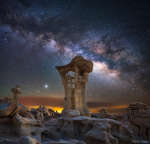 APOD: 2020 August 13 B Jupiter and Saturn Rising Beyond Alien Throne Rock
APOD: 2020 August 13 B Jupiter and Saturn Rising Beyond Alien Throne Rock
13.08.2020
Whatbplanets are those behind that unusualbrock spire? Saturn (lower left) and Jupiter.b This month, after sunset, the bright planetary duo are quite prominent toward the southeast.b Now your view of our Solar...
 The Shifting Tails of Comet NEOWISE
The Shifting Tails of Comet NEOWISE
12.08.2020
Keep your eye on the ion tail of Comet NEOWISE. A tale of this tail is the trail of the Earth. As with all comets, the blue ion tail always points away from the Sun. But as Comet C/2020 F3 (NEOWISE) rounded our Sun, its ion tail pointed in slightly different directions.
 Churning Clouds on Jupiter
Churning Clouds on Jupiter
11.08.2020
Where is Jupiter's ammonia? Gaseous ammonia was expected to be seen in Jupiter's upper atmosphere by the orbiting Juno spacecraft -- but in many clouds is almost absent. Recent Juno data, however, gives some clues: some high-level clouds appear to be home to an unexpected type of electrical discharge dubbed shallow lightning.
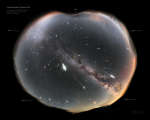 Perseids from Perseus
Perseids from Perseus
10.08.2020
Where are all these meteors coming from? In terms of direction on the sky, the pointed answer is the constellation of Perseus. That is why the meteor shower that peaks tomorrow night is known as the Perseids -- the meteors all appear to came from a radiant toward Perseus.
|
January February March April May |
|||||||||||||||||||||||||||||||||||||||||||||||||